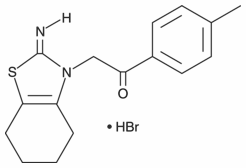All AbMole products are for research use only, cannot be used for human consumption.

Pifithrin-α (PFTalpha) is a reversible inhibitor of p53-mediated apoptosis and p53-dependent gene transcription such as cyclin G, p21/waf1, and mdm2 expression. It prevents p53-mediated apoptosis induced by cytotoxic compounds in C8 cells at 10 μM and in human umbilical vein endothelial cells at 30 μM. Pifithrin-α enhances cell survival after genotoxic stress such as UV irradiation and treatment with cytotoxic compounds including doxorubicin, etopoxide, paclitaxel, and cytosine-β-D-arabinofuranoside. Pifithrin-α protects mice from lethal whole body γ-irradiation without an increase in cancer incidence. Pifithrin-α can also protect cells from DNA damage-induced apoptosis by a p53-independent mechanism that might involve cyclin D1. In addition to p53, PFTalpha can suppress heat shock and glucocorticoid receptor signaling but has no effect on nuclear factor-kappaB signaling. Pifithrin-α (PFTalpha) reduces activation of heat shock transcription factor (HSF1) and increases cell sensitivity to heat. Moreover, Pifithrin-α reduces activation of glucocorticoid receptor and rescues mouse thymocytes in vitro and in vivo from apoptotic death after dexamethasone treatment.

Sci Total Environ. 2023 Dec;30:913:169730.
Selenium deficiency exacerbated Bisphenol A-induced intestinal toxicity in chickens: Apoptosis and cell cycle arrest mediated by ROS/P53
Pifithrin-α purchased from AbMole

Adv Sci (Weinh). 2022 Nov 22;10(1):e2204463.
Genetic and Pharmacological Inhibition of Astrocytic Mysm1 Alleviates Depressive-Like Disorders by Promoting ATP Production
Pifithrin-α purchased from AbMole

Ecotoxicol Environ Saf. 2022 Jun 1;237:113564.
Environmental BPDE induced human trophoblast cell apoptosis by up-regulating lnc-HZ01/p53 positive feedback loop
Pifithrin-α purchased from AbMole
| Molecular Weight | 367.3 |
| Formula | C16H18N2OS.HBr |
| CAS Number | 63208-82-2 |
| Solubility (25°C) | DMSO 57 mg/mL |
| Storage |
Powder -20°C 3 years ; 4°C 2 years In solvent -80°C 6 months ; -20°C 1 month |
| Related p53 Products |
|---|
| Pifithrin-α, p-Nitro, Cyclic
Pifithrin-α, p-Nitro, Cyclic (PFN-α) is cell-permeable and active-form p53 inhibitor. Pifithrin-α, p-Nitro, Cyclic behaves as a p53 posttranscriptional activity inhibitor. Pifithrin-α, p-Nitro, Cyclic do not prevent p53 phosphorylation on the S15 residue. |
| PK095
PK095 is a p53 mutant stabilizer. |
| HLI373
HLI373 is an efficacious Hdm2 inhibitor. |
| Cjoc42
Cjoc42 is a compound capable of binding to gankyrin. |
| MDM2-IN-1
MDM2-IN-1 is a synthetic MDM2-p53 interaction (MDM2) inhibitor and contains the trans (D-)configuration. |
All AbMole products are for research use only, cannot be used for human consumption or veterinary use. We do not provide products or services to individuals. Please comply with the intended use and do not use AbMole products for any other purpose.


Products are for research use only. Not for human use. We do not sell to patients.
© Copyright 2010-2024 AbMole BioScience. All Rights Reserved.
